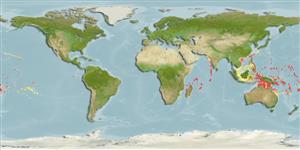>
Gobiiformes (Gobies) >
Gobiidae (Gobies) > Gobiinae
Etymology: aprica: Named for the eye-sized, brick red, round spot on the occipital region resembling the setting sun ('apricus' = sunny).
Eponymy: Susan Lee Jewett (formerly Susan J Karnella) (d: 1945). (Also see Jewett & Susan (Jewett)). In the genus’ name, ‘Sue’ is attached to Eviota, a related genus. (Ref. 128868), visit book page.
More on authors: Winterbottom & Hoese.
Environment: milieu / climate zone / depth range / distribution range
Écologie
marin récifal; profondeur 10 - 48 m (Ref. 39927). Tropical
Western Indian Ocean: Chagos Archipelago. Western Central Pacific: Indonesia. Recently reported from Tonga (Ref. 53797).
Taille / Poids / Âge
Maturity: Lm ? range ? - ? cm
Max length : 1.4 cm SL mâle / non sexé; (Ref. 39927)
Description synthétique
Clés d'identification | Morphologie | Morphométrie
Épines dorsales (Total) : 7; Rayons mous dorsaux (Total) : 10; Épines anales: 1; Rayons mous anaux: 9. Second dorsal fin with 1 spine and 10 soft rays; first and second dorsal spines filamentous in males. Anterior nasal tube 7% HL and with a dusky tip. A red, eye-diameter-sized spot on occipital region of the head. Presence of nasal, and anterior and posterior interorbital and infraorbital sensory-canal pores, all other pores absent (Ref. 39927); characterized further by semi-translucent pale yellowish to whitish overall; head pink with orange and red bars/bands; body with around six internal brown bars; narrow brown scale margins; yellowish fins with brownish spot at base of anterior dorsal spines; absence of pelvic frenum; caudal rays branched 12; longitudinal scale series 26-27; body with ctenoid scales except cycloid on midline of abdomen; depth of body 4.0-4.4 in SL (Ref. 90102).
Collected in well-developed caves on drop-offs and may be restricted to this habitat (Ref. 39927).
Life cycle and mating behavior
Maturité | Reproduction | Frai | Œufs | Fécondité | Larves
Winterbottom, R. and D.F. Hoese, 1998. A new genus and four new species of fishes from the Indo-West Pacific (Pisces; Perciformes; Gobiidae), with comments on relationships. R. Ont. Mus. Life Sci. Occas. Pap. (37):1-17. (Ref. 39927)
Statut dans la liste rouge de l'IUCN (Ref. 130435: Version 2024-1)
Menace pour l'homme
Harmless
Utilisations par l'homme
Pêcheries: sans intérêt
Outils
Articles particuliers
Télécharger en XML
Sources Internet
Estimates based on models
Preferred temperature (Ref.
123201): 26.1 - 28.8, mean 27.6 °C (based on 186 cells).
Phylogenetic diversity index (Ref.
82804): PD
50 = 0.5078 [Uniqueness, from 0.5 = low to 2.0 = high].
Bayesian length-weight: a=0.01023 (0.00477 - 0.02194), b=3.01 (2.83 - 3.19), in cm total length, based on LWR estimates for this (Sub)family-body shape (Ref.
93245).
Niveau trophique (Ref.
69278): 3.0 ±0.3 se; based on size and trophs of closest relatives
Résilience (Ref.
120179): Faible, temps minimum de doublement de population : 4,5 à 14 années (Assumed Fec < 100).
Fishing Vulnerability (Ref.
59153): Low vulnerability (10 of 100).
